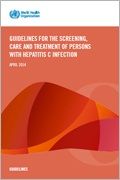Article
World Health Organization Issues Hepatitis C Treatment Guidelines
Author(s):
New guidance from the WHO includes nine key recommendations covering screening, treatment, alcohol use assessment and counseling, and measures to prevent transmission of the virus.

With an eye on saving lives from the destructive grasp of hepatitis C, the World Health Organization (WHO) recently issued its first guidance for the treatment of the liver-damaging virus that health officials say contributes to hundreds of thousands of deaths each year around the world.
Chronic infection of hepatitis C affects an estimated 130 million to 150 million people and leads to an annual loss of life of upwards of 500,000, according to WHO officials. There is currently no vaccine for the virus, which is most commonly transmitted through exposure to contaminated blood and can remain symptom-free in the body for years before liver damage is detected.
Rapid advances in drugs that treat hepatitis C at better and faster rates have prompted new worldwide attention to the creation or revision of hepatitis C treatment guidelines. The WHO Guidelines for the Screening, Care, and Treatment of Persons with Hepatitis C Infection were announced the same week that numerous study results for hepatitis C drugs were discussed at the European Association for the Study of the Liver conference in London.
“The WHO recommendations are based on a thorough review of the best and latest scientific evidence,” Dr. Stefan Wiktor, head of WHO’s Global Hepatitis Programme, said in a statement. “The new guidance aims to help countries to improve treatment and care for hepatitis and thereby reduce deaths from liver cancer and cirrhosis.”
Treatment recommendations address both the use of traditional approaches with interferon injections and newer drugs that treat the virus with oral medications. The organization plans to update its new guidelines to keep up with emerging evidence and regulatory approvals of new antiviral medications.
The WHO guidelines suggest ways to get more high-risk people screened for the virus and how to choose and administer appropriate treatments for chronic infection. Also included among nine key recommendations are measures to curb liver damage by offering alcohol assessments and counseling for those who already know they have the virus in order to reduce abuse among moderate to high-use alcohol drinkers.
To stem the spread of the blood-borne virus among the high-risk population of people who inject drugs and share needles, health officials advocate policies that support intervention programs and training among health care workers, as well as safety measures to limit exposure in health care settings. Higher rates of new hepatitis C plague countries where screening to detect the virus is not conducted before blood transfusions and reuse of contaminated needles is prevalent.
Hepatitis C and B have the greatest public health impact among the five main hepatitis viruses because they cause chronic infection which can progress to cirrhosis and liver cancer.
Earlier this year, a joint venture of US medical and research associations established an online mechanism for updating hepatitis C treatment guidance faster than previous time frames of every few years (the last update had been in 2011). The website, HCVguidelines.org, is backed by the American Association for the Study of Liver Diseases, the Infectious Diseases Society of America, and the International Antiviral Society-USA.




